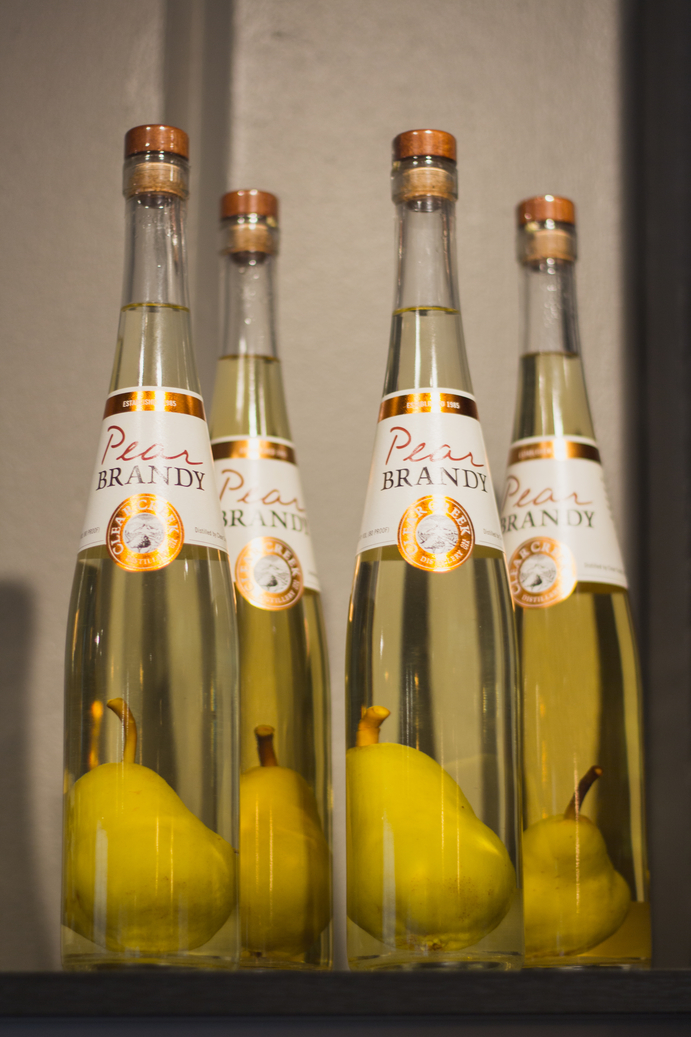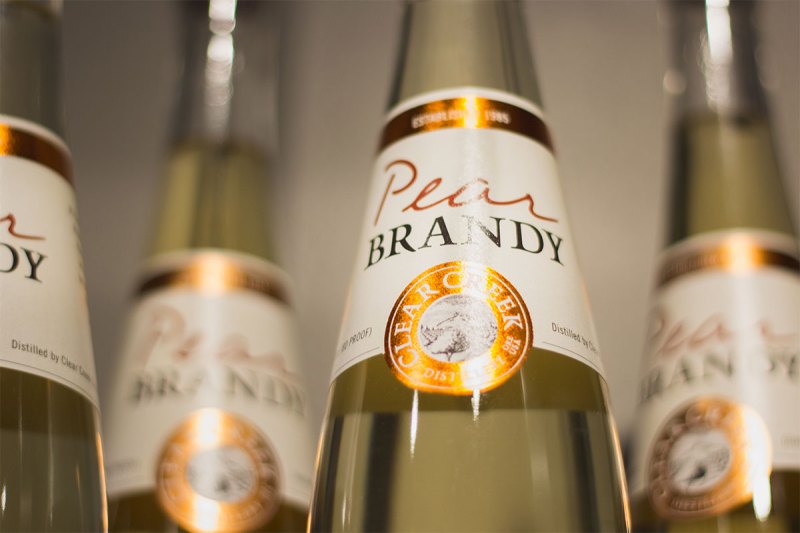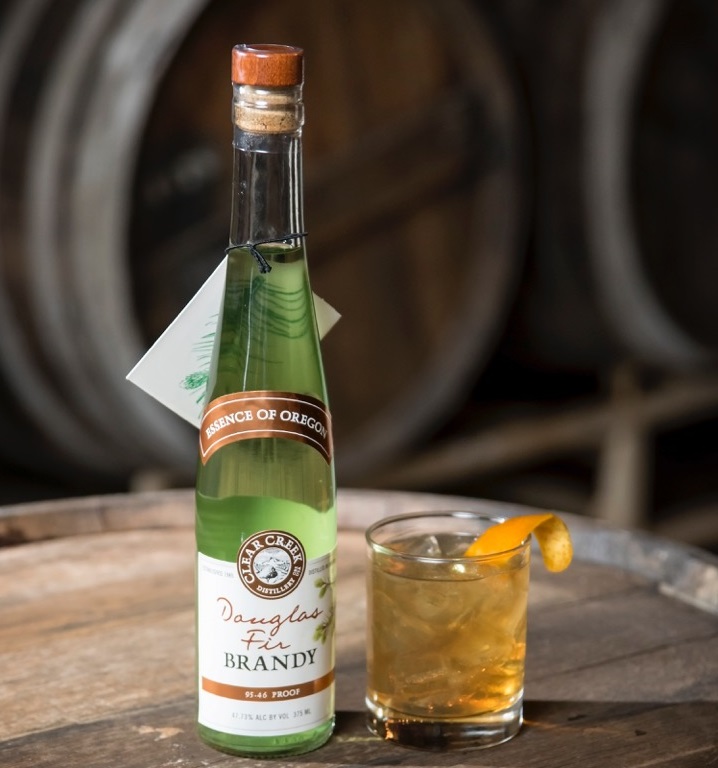I’ll admit, before visiting Portland’s Clear Creek Distillery, I was a brandy virgin. And not just in the “I haven’t ever tried the stuff before” sort of way, but more like an “I’ve never even seen a bottle of brandy in real-life” full-blown virginism.
Sure, I’ve read about brandy in books and I’ve seen it sipped from crystal glasses as an after dinner drink consumed by British aristocrats and American robber barons during the Edwardian era on Downton Abbey and Titanic. But, I had no idea that brandy, contrary to what the media has been intimating to me my entire life, is a (mostly) dry spirit with extremely high alcohol content–we’re talking between 80 and 90 proof (40-45% ABV)–that drinks more like scotch than its most closely associated precursor, wine. It is definitely not a grandma drink–unless your grandma is hardcore.
And so, to get a better idea of what brandy actually is and some more information on how exactly it’s made, I met up with Clear Creek Distillery’s Head Distiller and Production Manager, Daniel Ruiz, at their Northwest Portland, Oregon location. Clear Creek has been in the brandy game for over three decades, so we felt it more than appropriate to get the scoop straight from the horse’s mouth. Check out the video below for a behind the scenes look at Clear Creek Distillery’s production and bottling facilities.
But before we jump in headlong, we should warn you that there is–like with most spirits and liquors–a very specific vocabulary used to describe brandy, the production process, and its boozy compatriots. Check out the nomenclature-to-know below before reading on.
Mash: is the first step in making brandy and consists of crushed whole fruit that has been smashed into an apple-sauce consistency. At Clear Creek, their mash contains cores, seeds, stems and all, so nothing goes to waste.
Pomace: is the solid remains of grapes or other fruit after pressing for juice (wine), and contains the skins, pulp, seeds, and stems of the fruit. Pomace is used as the base for grappa.
Brandy: (not the actor-singer) is a spirit made from distilled grape wine. Brandy also technically describes liquors made from distilling pomace, mash, or the wine of any other fruit—these are often also called eaux de vie.
Eau de vie: is a clear fruit brandy made from the fermentation and double distillation of fruits other than grapes.
Grappa: is a grape-pomace based brandy of Italian origin that contains 35 to 60 percent alcohol.
Now that you’ve had your vocabulary lesson for the day, back to brandy.
Ruiz has brought his expertise in distillation and fermentation as Head Distiller at Clear Creek for the past decade and so, it comes as no surprise that he was more than happy to give us an informative summary of how Clear Creek came to make brandy, the brandy-making process, and other spirits that Clear Creek distills.
Why Brandy?
Clear Creek Distillery was started in 1985 by Steven McCarthy who had previously been in the outdoor equipment business. While on sales trips to Europe, McCarthy had the truly European experience of partaking in a post-dinner digestif of brandy. He fell in love with pear brandy in particular and knew he wanted to bring it to the United States where, at that time, production of the liquor was next to nothing.
What really transformed McCarthy’s dream into reality was the fact that the pear used to make his favorite brandy in Europe was, coincidentally and serendipitously, the exact same type of pear his family had been growing on their Oregon orchard for years–the Bartlett, also known as the Williams pear. And so, with pears in hand and the purchase of a few Arnold Holstein copper pot stills, McCarthy set out creating the Clear Creek Distillery we know today.
How It’s Made
While visiting the distillery, Clear Creek was in the process of making their famous pear brandy and the scent of sweet, ripe pears filled the cavernous distillation room, making the whole place smell like an orchard on a warm autumn day.
Ruiz described the brandy making process as, “the same process as making wine, but with an additional step at the end.” He elaborated, “You get a fruit [in this case, pears] crush the fruit, add yeast, let it ferment, and then take that fermented [alcoholic] fruit (now called the wine) and put it into a pot still and distill it. The distillation process is this: alcohol has a lower boiling point than water, so when you heat up the wine, the alcohol vapor boils off and carries over the volatile fruit aromatics, which rise through the still and then go through a condenser where the vapor is cooled down and liquidized again, and you have brandy.”

Some of Clear Creek’s Pear Brandy is sold with a single pear within the bottle, which adds a lux factor not found in other brandies. The method for getting a pear in a bottle is a fairly simple process of placing a brandy bottle over the early spring buds of pear trees in Hood River, Oregon. Nearby pear buds and branches are removed from the tree so that it’s nutrients go entirely toward the one pear in the jar. Once the pears have reached the appropriate size, the bottle (pear and all) is cut from the tree, hand-washed, and then filled with the brandy. These bottles are a little more expensive, but that’s understandable, given that all this work must be done by hand.
Once we finished the tour of the distillery’s facilities, I was led to Clear Creek’s tasting room where I delighted in sampling almost every spirit Clear Creek produces. Again, these are high alcohol spirits, so I shouldn’t have been surprised when I left Clear Creek a little on the tipsy side, even though I didn’t finish a single sample in its entirety.
Tasting
Pear Brandy: 80 proof, bone dry with no sugar added. Most people simply sip this brandy like a scotch or whiskey, but recently craft cocktails have utilized it in daquiris and a Pear Collins. Crisp pear flavors and aromas permeate this brandy, while the end provides a lingering note that’s almost vanilla in flavor.
Reserved Apple Brandy, 8 years– Made with golden delicious apples sourced from the Yakima Valley in Washington, this eight-year aged brandy brings apple notes in the front of the pallet and a nice rich, brown-sugar, oaky finish. It almost has a whiskey sort of feel to it, so if you’re a fan of the brown stuff, this one is for you.
Pinot Noir Grappa– With flavors of mushroom, wet straw, tobacco, and coming in at 85 proof, the Pinot Noir Grappa certainly has an interesting kick. The spirit smells like grape skins—which comes directly its pinot noir pomace base, and that aroma permeates the entire tasting experience. This was definitely my least favorite of the bunch, but Clear Cleek noted that lot of people enjoy this grappa because it reminds them of past trips to Tuscany where grappa is well-known and well-loved.
American Pot Still Brandy—This is a four grape blend, comparable to a traditional Armagnac (a single Cognac distillate from the Armagnac region of France). Flavors of butterscotch, vanilla, toffee, with a nectarine finish. Even a little spicey in a way. Very smooth.
And speaking of smooth, Clear Creek Distillery doesn’t just focus on fruit spirits and brandy, they also make a killer single-malt whiskey.
McCarthy’s Oregon Single Malt Whiskey
Clear Creek produces only one whiskey–a peated whiskey by the name of McCarthy’s Oregon Single Malt Whiskey. For those of you who don’t know, peated whiskey is produced using peated malt. As Ruiz explains, “Malting is the process of taking barley or grain and hydrating it and then drying it out so it’s ready for brewing. And the final process of malting is when you kiln or dry out the malt to keep it stable for transportation. Back in Scotland (where the peated malt is sourced), historically their heat source was peat moss. So they’d take that peat and use it to dry out their malt, literally burning it, which gives the malt a really rich, smokey aroma. So all that barley that was drying out sucks up all that smoke character. The malt we get is very smokey and so that transfers to the whiskey and is reflected in the taste and flavor.”
Clear Creek gets their peated whiskey malt directly from Scotland, which they then ferment, distill, and follow up with a three year aging period in Oregon oak. According to Ruiz, “Most scotch is aged in used bourbon or sherry barrels. We use mostly Oregon oak barrels–both new and used. We do a medium toast, so our barrels aren’t charred on the inside.” Using Oregon oak was one way for Clear Creek to tie-in local products, since all their fruit spirits are made from local fields and orchards. In the Whiskey Bible’s review of the world’s whiskeys, McCarthy’s was recognized as the “Best Small Batch Whiskey” in both 2004 and 2006.
Beyond whiskey and pear brandy, Clear Creek also makes one of the most unique spirits in America–the Douglas Fir Brandy.
Douglas Fir Brandy
Clear Creek descibres this brandy as, “Also an eau de vie, [it] is made from bright green springtime Douglas fir buds, hand picked, and immediately infused in Clear Creek’s delicate and aromatic brandy. This maceration is then re-distilled and re-infused with fresh new buds, giving the spirit its vibrant green hue from the Douglas fir’s natural chlorophyll. No artificial color has been added.”
The Douglas Fir brandy is almost a forest in a glass. With woody, piney notes, a little vanilla, and a bit of earthiness, this brandy has a long-lasting flavor profile that you won’t soon forget. But, because the flavor is so unique and strong (not to mention it’s bright, natural color), bartenders and mixologists have taken to using this brandy as a component in an ever-increasing variety of cocktails. Matt Mount, of Merit Badge has kindly provided us a cocktail recipe below. Try it out for yourself and enjoy!
Forest Old-Fashioned Recipe
From Matt Mount, Merit Badge
Ingredients
- 2 oz. Temperance Trader Bourbon (or your favorite straight Bourbon)
- 1/4 oz. Clear Creek Douglas Fir Eau de Vie
- 1/4 oz. cane sugar syrup (1:1 ratio of water to granulated sugar)
- 4 dashes of The Bitter Housewife Aromatic Bitters
Method
Combine all ingredients in cocktail shaker and then add ice. Stir, strain over fresh ice and serve in a double old-fashioned glass and garnish with a small pinch of Jacobsen Salt and orange peel.
Sunday: 12:00pm-6:00pm










